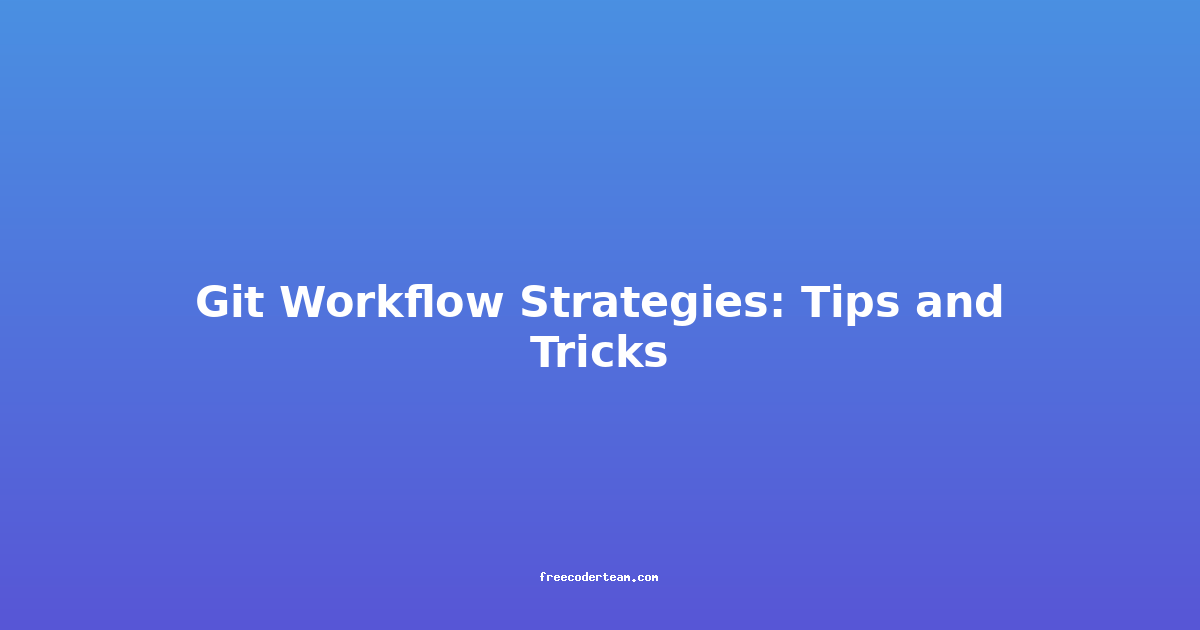Git Workflow Strategies: Tips and Tricks
Git is a powerful version control system that allows developers to manage code changes effectively, collaborate seamlessly, and maintain a clean, organized history. However, simply using Git isn't enough—having a well-defined workflow strategy ensures that your team remains productive, minimizes conflicts, and keeps your codebase in top shape. In this blog post, we'll explore various Git workflow strategies, best practices, and actionable tips to help you optimize your development process.
Table of Contents
- Understanding Git Workflow
- Common Git Workflow Strategies
- Best Practices for Effective Git Workflow
- Tips and Tricks for Streamlined Workflows
- Conclusion
Understanding Git Workflow
Before diving into specific strategies, it's essential to understand what a Git workflow entails. A Git workflow is a set of guidelines and practices that dictate how developers use Git to manage their codebase. It outlines how branches are created, merged, and managed, as well as how changes are reviewed and deployed.
A well-defined workflow ensures that:
- Changes are organized: Developers know how to structure their work.
- Collaboration is smooth: Teams can work together without stepping on each other's toes.
- Code quality is maintained: Review processes and automated checks help catch issues early.
- Deployment is predictable: The main branch is always in a deployable state.
Common Git Workflow Strategies
Different projects and teams may require different workflow strategies depending on their size, complexity, and needs. Here are four popular Git workflow strategies:
Fork & Pull Model
The Fork & Pull Model is commonly used on platforms like GitHub. It's ideal for open-source projects where contributors may not have direct write access to the main repository.
How It Works:
- Fork the Repository: Developers fork the main repository to create their own copy.
- Create a Branch: Developers create a new branch for their changes.
- Push Changes: Changes are pushed to the forked repository.
- Submit a Pull Request (PR): Developers submit a PR to the main repository.
- Review and Merge: The maintainers review the PR and merge it into the main repository if it meets the criteria.
Example:
# Fork the repository on GitHub
git clone https://github.com/your-fork/repo.git
# Create a new branch for your changes
git checkout -b feature/my-new-feature
# Make changes and commit them
git add .
git commit -m "Add a new feature"
# Push to your fork
git push origin feature/my-new-feature
# Submit a pull request on GitHub
Pros:
- Access Control: Maintainers have full control over what gets merged.
- Easy Onboarding: New contributors don't need direct access to the main repository.
Cons:
- Merge Overhead: Maintainers need to review and merge each PR manually.
- Branch Management: Multiple forks can lead to fragmented histories.
Git Flow
Git Flow is a widely adopted branching model that defines specific branches for different purposes (e.g., develop, feature, release, hotfix). It's designed for teams that need to manage multiple releases and branches simultaneously.
Key Branches:
- Main: Contains production-ready code.
- Develop: A branch where features are integrated before release.
- Feature: Short-lived branches for new features.
- Release: Branches used to prepare stable releases.
- Hotfix: Branches for fixing production issues.
Example:
# Create a feature branch from develop
git checkout -b feature/new-feature develop
# Make changes and commit them
git add .
git commit -m "Implement new feature"
# Merge feature branch into develop
git checkout develop
git merge --no-ff feature/new-feature
git branch -d feature/new-feature
# Create a release branch from develop
git checkout -b release/1.2 develop
# Make any necessary changes and finalize the release
git tag v1.2
git checkout develop
git merge --no-ff release/1.2
git checkout main
git merge --no-ff release/1.2
git push origin main
# Clean up
git branch -d release/1.2
Pros:
- Clear Structure: Each branch has a specific purpose.
- Scalability: Works well for teams managing multiple releases.
Cons:
- Complexity: Requires strict adherence to rules.
- Overhead: Managing multiple branches can be cumbersome for small projects.
Trunk-Based Development
Trunk-Based Development is a minimalist approach where all changes are integrated directly into the main branch (main or master). It's ideal for small teams or projects that prioritize simplicity and frequent deployments.
How It Works:
- Single Source of Truth: All developers work directly on the main branch.
- Continuous Integration: Changes are regularly merged into the main branch.
- Automated Testing: Rigorous testing ensures that the main branch remains stable.
Example:
# Checkout the main branch
git checkout main
# Make changes and commit them
git add .
git commit -m "Fix a bug"
# Push changes to the main branch
git push origin main
Pros:
- Simplicity: No need for complex branching.
- Frequent Deployments: Changes are always ready for production.
Cons:
- Risk of Instability: Requires robust testing to ensure the main branch is always stable.
- Merge Conflicts: More frequent merges can lead to conflicts.
GitHub Flow
GitHub Flow is a lightweight branching model that focuses on simplicity and continuous deployment. It's similar to Trunk-Based Development but includes feature branches for isolation.
How It Works:
- Feature Branches: Developers create feature branches from the main branch.
- Pull Requests: Changes are reviewed via PRs before merging into the main branch.
- Continuous Integration: Automated tests ensure that the main branch is always deployable.
- Deploy from Main: The main branch is the source of truth for production.
Example:
# Create a feature branch from main
git checkout -b feature/new-feature main
# Make changes and commit them
git add .
git commit -m "Implement new feature"
# Push to the remote repository
git push origin feature/new-feature
# Submit a pull request
Pros:
- Simplicity: Easy to understand and implement.
- Collaboration: PRs ensure code is reviewed before merging.
Cons:
- Branch Management: Feature branches can accumulate over time.
- Risk of Instability: Requires robust testing to maintain main branch stability.
Best Practices for Effective Git Workflow
Regardless of the workflow strategy you choose, following best practices can significantly improve your team's productivity and code quality.
Commit Messages
Well-written commit messages are crucial for maintaining a clear and understandable Git history. Follow these guidelines:
- Be Concise: Use a short, descriptive subject line (e.g., "Fix bug in authentication").
- Use the Present Tense: Write as if the commit is happening now (e.g., "Fix bug" instead of "Fixed bug").
- Provide Context: Add a detailed description if the subject line isn't enough.
Example:
# Good commit message
git commit -m "Fix authentication issue
Users were unable to log in due to a typo in the API endpoint. This commit corrects the endpoint URL and adds a test to prevent future regressions."
Branch Naming Conventions
Consistent branch naming helps developers understand the purpose of each branch at a glance. Use prefixes to categorize branches (e.g., feature/, bug/, hotfix/).
Example:
feature/add-user-profilebug/fix-login-issuehotfix/security-patch
Code Reviews
Code reviews are essential for catching bugs, improving code quality, and ensuring consistency. Follow these tips:
- Review Early and Often: Don't wait until a PR is complete to start the review.
- Provide Constructive Feedback: Focus on solutions rather than criticism.
- Use Automation: Tools like GitHub Actions can automate linting and testing.
Regular Rebasing
Rebasing can help keep your Git history clean and linear. Instead of merging a branch into another, rebasing applies your commits on top of the target branch.
Example:
# Rebase your feature branch onto main
git checkout feature/my-feature
git rebase main
Benefits:
- Clean History: No merge commits cluttering the history.
- Conflict Resolution: Easier to resolve conflicts before merging.
Tips and Tricks for Streamlined Workflows
Using Feature Flags
Feature flags allow you to toggle features on or off without deploying new code. They're particularly useful for large teams or projects that require frequent releases.
Example:
# Using a feature flag
if settings.FEATURE_FLAG_ENABLE_X:
# Enable feature X
implement_feature_x()
Automated Testing and CI/CD
Automated testing and continuous integration/continuous deployment (CI/CD) ensure that your code is always in a deployable state. Set up workflows to run tests and linting automatically when changes are pushed or merged.
Example:
# GitHub Actions workflow
name: Test and Lint
on:
pull_request:
branches:
- main
jobs:
test:
runs-on: ubuntu-latest
steps:
- uses: actions/checkout@v2
- name: Run Tests
run: pytest tests/
- name: Lint Code
run: flake8 .
Keeping the Main Branch Clean
The main branch should always be in a deployable state. Use the following practices to keep it clean:
- Use Pull Requests: Require all changes to go through a PR review.
- Automated Checks: Enforce linting, testing, and code quality checks.
- Release Branches: Use release branches for final stabilization before deployment.
Conclusion
Git workflows are a critical component of successful software development. By choosing the right workflow strategy and following best practices, you can ensure that your team remains productive, your codebase remains organized, and your deployments are smooth.
Whether you prefer the simplicity of GitHub Flow, the structure of Git Flow, or the flexibility of Trunk-Based Development, the key is to tailor your workflow to your team's needs and maintain consistency. By implementing tips like clean commit messages, automated testing, and feature flags, you can further enhance your workflow and deliver high-quality software.
Happy coding, and may your Git history remain as clean as your code! 🚀
If you have any questions or need further clarification, feel free to reach out!




